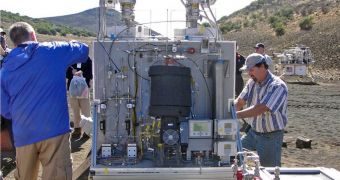Officials at the American space agency say that a new mission called the Resource Prospector Mission (RPM) could be developed at NASA over the coming years. The RPM would include a rover capable of extracting volatiles from the lunar surface, and then synthesize water with these chemicals.
The development of this mission was brought on by the slew of new discoveries made on the surface of Earth's natural satellite, where hydrogen and water-ice were found to abound. These chemicals could easily be used to produce water. This basic chemical can then be split into hydrogen and oxygen.
As such, a simple machine that manufactures water could enable human settlements on the Moon in the future. Hydrogen can be used as rocket fuel, while oxygen can be used to create a breathable atmosphere inside pressurized modules on the lunar surface.
An instrument called the Regolith and Environment Science and Oxygen & Lunar Volatile Extraction (RESOLVE) payload would lie at the core of the RPM mission, Space News reports. The instrument was proposed by experts with the Advanced Exploration Systems Division at the NASA Human Exploration and Operations Mission Directorate.
When successfully deployed on the Moon, the RPM/RESOLVE combo would become the first demonstrators of in-situ resource utilization (ISRU) techniques beyond the surface of our planet. Some NASA experts suggest a launch date for the mission sometime in 2018.
Thus far, the American space agency has spent around $20 million (€14.6 million) on developing RPM. Current estimates place the total cost of the initiative at around $250 million (€183 million).
“The concept of RPM came up out of the need to fly RESOLVE and the near-term, close way to test that would be on the Moon. A lot of the technologies have broader use than just lunar, so RPM is not about a lunar mission per se. It’s just a convenient location to be testing the ISRU technology,” explains the chief technologists for space operations at NASA, Jason Crusan.
If RESOLVE is successful on the lunar surface, than a second ISRU payload could be launch to Mars, aboard a rover NASA has tentatively scheduled for launch sometime in 2020.

 14 DAY TRIAL //
14 DAY TRIAL //